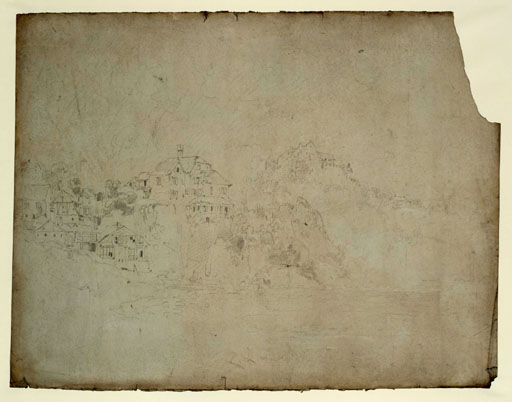Joseph Mallord William Turner Schaffhausen: Looking across the Rhinefall to Laufen Castle 1802
Image 1 of 2
Joseph Mallord William Turner,
Schaffhausen: Looking across the Rhinefall to Laufen Castle
1802
Joseph Mallord William Turner 1775–1851
Schaffhausen: Looking across the Rhinefall to Laufen Castle 1802
D04875
Turner Bequest LXXIX A
Turner Bequest LXXIX A
Pencil and white chalk on white wove paper prepared with a grey wash, 559 x 726 mm (irregular)
Watermarked ‘HAYES & WISE | 1799’
Stamped in black ‘LXXIX A’ bottom right
Watermarked ‘HAYES & WISE | 1799’
Stamped in black ‘LXXIX A’ bottom right
Accepted by the nation as part of the Turner Bequest 1856
References
1909
A.J. Finberg, A Complete Inventory of the Drawings of the Turner Bequest, London 1909, vol.I, p.210, LXXIX A, as ‘Falls of Schaffhausen, with Castle in middle distance’.
1981
Lindsay Stainton, in Maurice Guillaud and others, Turner en France: aquarelles, peintures, dessins, gravures, carnets de croquis / Turner in France: Watercolours, Paintings, Drawings, Engravings, Sketchbooks, exhibition catalogue, Centre Culturel du Marais, Paris 1981, p.82.
1990
Peter Bower, Turner’s Papers: A Study of the Manufacture, Selection and Use of his Drawing Papers 1787–1820, exhibition catalogue, Tate Gallery, London 1990, pp.86–7.
1992
David Hill, Turner in the Alps: The Journey through France & Switzerland in 1802, London 1992, pp.150–1 reproduced, 169.
1993
Mungo Campbell, A Complete Catalogue of Works by Turner in the National Gallery of Scotland, Edinburgh 1993, p.83 under no.36.
The Rhinefall at Schaffhausen was one of the highlights of Turner’s Continental tour in 1802 and his last experience that summer of the forces of nature at their most sublime. In Paris on his return journey he described the scale of the falls to Joseph Farington: ‘The Great fall at Schaffhausen is 80 feet, – the width of the fall about four times and a half greater than its depth. The rocks above the fall are inferior to those above the fall of the Clyde, but the fall itself is much finer.’1
Working on the spot, managing as best he could to avoid the spray, Turner made sketches from near the falls in his Swiss Figures and Fonthill sketchbooks (Tate D04817; Turner Bequest LXXVIII 18a and Tate D02203, D02206–D02208, D02229–D02230; Turner Bequest XLVII 26, 29–31, 52–3). Then he crossed to the west bank of the river and made five drawings on large folio sheets, already prepared with a grey ground, which he had brought from London; the others are D04876–D04879; Turner Bequest LXXIX B–E.
David Hill imagines Turner spending ‘at least a full afternoon’ at work on the large drawings.2 This view, taken from beside the falls, was probably the first to be made. Laufen Castle, with its gabled walls, stands on the opposite bank of the Rhine. The main focus is on the architecture of the castle and other buildings alongside the river. Having drawn these, Turner worked his way round to the right, choosing viewpoints further downstream.
Turner knew the painter P.J.de Loutherbourg (1740–1812) well and probably remembered his picture of the Rhinefall painted after a visit to Switzerland in 1787–8 (Victoria and Albert Museum, London). One of Turner’s large drawings (D04878; Turner Bequest LXXIX D) is similar in depicting the falls head on, parallel to the picture plane. However, in his other drawings Turner sought out closer or angled viewpoints that emphasise their scale and drama. Even so, none of these drawings served directly for his picture Fall of the Rhine at Schaffhausen exhibited at the Royal Academy in 1806 (Museum of Fine Arts, Boston);3 this takes the viewer to the riverbank, immediately in front of an onslaught of water that would have made it impossible to draw, especially on a large sheet of paper.
Technical notes:
The paper is a white wove watermarked ‘HAYES & WISE 1799’. The sheet was originally made to Imperial size. It was prepared in advance on both sides with grey wash, doubtless by Turner himself. Peter Bower suggests that the ground was ‘of Turner’s own devising, and whilst it may contain some soot a major component may be the notoriously fugitive pigment indigo’; he quotes an early nineteenth-century source describing the preparation of ‘bistred paper’ for ‘designing on’ by washing the sheet with a sponge dipped in sooty water; this was in order to ‘save the labour of the crayon, in places which are to be shadowed the same depth with the teint of this paper. For light places, they are made thereon with white chalk.’1 Finberg believed the ground meant ‘that lights can be rubbed out’, Bower that they are often achieved by rubbing down to the original white of the paper although white chalk or gouache have also been observed. The grey ground would also have helped to reduce glare when working outdoors. Loose sheets like this were presumably carried in portfolio, rolled or folded.
The sheet is trimmed and damaged around the margins; a portion of the top right corner is missing.
Verso:
Laid down
David Blayney Brown
January 2012
How to cite
David Blayney Brown, ‘Schaffhausen: Looking across the Rhinefall to Laufen Castle 1802 by Joseph Mallord William Turner’, catalogue entry, January 2012, in David Blayney Brown (ed.), J.M.W. Turner: Sketchbooks, Drawings and Watercolours, Tate Research Publication, September 2014, https://www


